Tai Chi eases anxiety through its unique blend of slow, deliberate movements and focused breathing techniques. As a beginner, you'll find that this ancient Chinese practice promotes mindfulness, connecting your body and mind. The gentle, flowing postures activate your parasympathetic nervous system, reducing stress hormones and calming your nerves. You'll learn to breathe deeply, enhancing relaxation and mental clarity. Regular practice builds physical balance and emotional equilibrium, while group classes offer social support. By establishing a consistent routine, you'll develop lasting tools for anxiety management. Discovering the right Tai Chi style for you can initiate a transformative journey toward inner peace.
Understanding Tai Chi's Ancient Roots
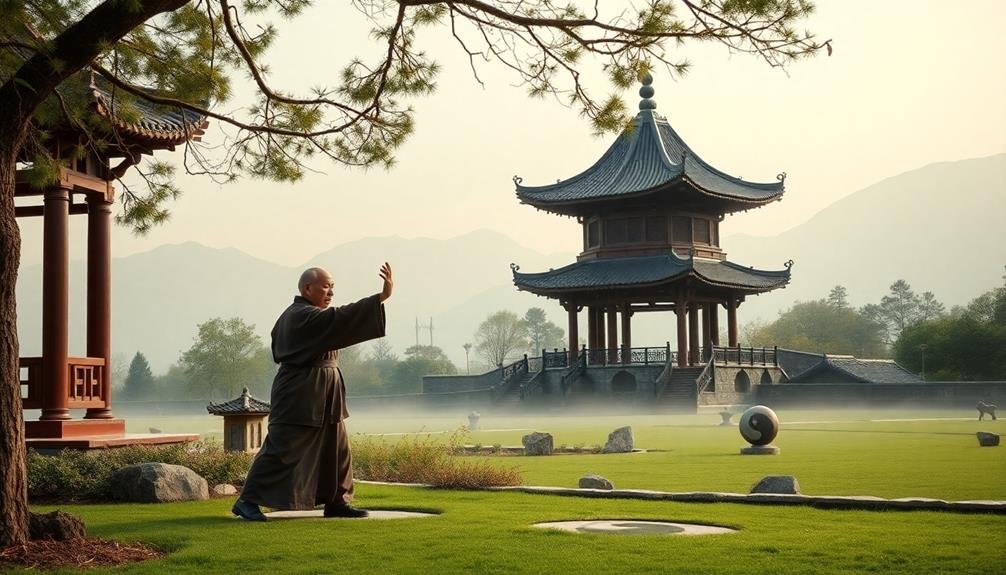
Tai Chi's roots stretch back over two millennia to ancient China. This ancient practice originated as a martial art, blending physical movement with philosophical principles from Taoism and Traditional Chinese Medicine.
You'll find that Tai Chi's core concepts revolve around the balance of opposing forces, known as yin and yang, and the flow of essential energy called qi.
Initially developed for self-defense, Tai Chi evolved into a holistic system for promoting physical and mental well-being. Its slow, graceful movements are designed to cultivate inner calm and improve body awareness.
As you practice, you'll learn to coordinate your breath with each pose, enhancing the mind-body connection.
Throughout its history, Tai Chi has been refined and adapted into various styles, each with its unique emphasis. The most popular forms today include Yang, Chen, Wu, and Sun styles.
Despite these variations, all forms share the fundamental principles of relaxation, mindfulness, and gentle, flowing movements.
Mind-Body Connection in Tai Chi
At the heart of this ancient practice lies a powerful mind-body connection. As you perform Tai Chi, you'll notice how your physical movements directly influence your mental state, and vice versa. This integration is key to reducing anxiety and promoting overall well-being.
When you engage in Tai Chi, you're not just moving your body; you're also cultivating mindfulness. Each slow, deliberate movement requires your full attention, effectively pulling your mind away from anxious thoughts. You'll focus on your breath, coordinating it with your movements, which naturally calms your nervous system.
The gentle, flowing motions of Tai Chi encourage relaxation in your muscles, which in turn signals your brain to relax. This physical ease translates into mental tranquility. As you practice regularly, you'll develop greater body awareness, helping you recognize and release tension more easily in daily life.
Tai Chi's emphasis on balance and stability also fosters a sense of groundedness, both physically and mentally. This can be particularly beneficial when you're feeling overwhelmed or anxious, providing a tangible way to center yourself.
Breathing Techniques for Anxiety Relief
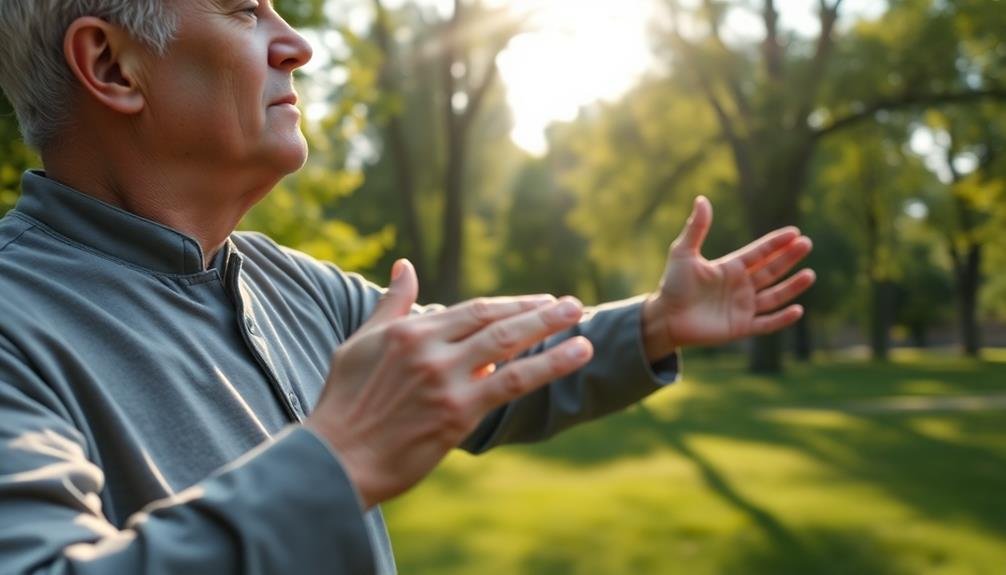
Proper breathing lies at the core of Tai Chi's effectiveness in reducing anxiety. As you practice Tai Chi, you'll learn to focus on your breath, which can help calm your mind and body.
The slow, deliberate breathing techniques used in Tai Chi can activate your parasympathetic nervous system, reducing stress and promoting relaxation.
To incorporate Tai Chi breathing for anxiety relief, try these techniques:
- Diaphragmatic breathing: Place one hand on your chest and the other on your belly. Inhale deeply through your nose, allowing your belly to expand while keeping your chest still. Exhale slowly through your mouth.
- 4-7-8 breathing: Inhale quietly through your nose for a count of 4, hold your breath for 7 counts, then exhale completely through your mouth for 8 counts.
- Mindful breathing: Focus your attention on the sensation of your breath entering and leaving your body, letting go of other thoughts as they arise.
Slow Movements and Stress Reduction
Tai Chi's slow, deliberate movements can noticeably reduce your stress levels.
As you practice, you'll combine mindful breathing techniques with gentle, flowing postures to create a meditative experience.
This combination, coupled with a calming mental focus, helps quiet your mind and ease anxiety symptoms.
Mindful Breathing Techniques
Mindful breathing techniques form a cornerstone of Tai Chi practice for anxiety relief. As you engage in Tai Chi movements, you'll learn to synchronize your breath with each motion, creating a harmonious flow between body and mind. This synchronization helps quiet anxious thoughts and brings your focus to the present moment.
To incorporate mindful breathing into your Tai Chi practice:
- Start with deep abdominal breathing: Place one hand on your belly and inhale slowly through your nose, feeling your abdomen expand. Exhale through your mouth, allowing your belly to fall.
- Practice the "counting breath": Inhale for a count of four, hold for two, then exhale for six. This pattern helps regulate your nervous system and promotes relaxation.
- Use visualization: Imagine breathing in calming energy and exhaling tension with each breath cycle. This mental imagery can enhance the anxiety-reducing effects of your practice.
As you become more proficient in these techniques, you'll find that mindful breathing becomes second nature during your Tai Chi sessions.
You'll be able to carry this skill into everyday life, using it as a powerful tool to manage anxiety in stressful situations.
Gentle Flowing Postures
The hallmark of Tai Chi's approach to anxiety relief lies in its gentle, flowing postures. These slow, deliberate movements form the core of your practice, promoting relaxation and stress reduction. As you perform each posture, you'll focus on smooth shifts, allowing your body to move with grace and fluidity.
You'll start with basic stances like "White Crane Spreads Its Wings" or "Cloud Hands," gradually progressing to more complex sequences. Each movement is designed to promote balance, flexibility, and body awareness. By concentrating on these flowing forms, you'll naturally redirect your attention away from anxious thoughts.
The slow pace of Tai Chi encourages you to be present in the moment, connecting your mind and body. This mindful movement practice helps release tension in your muscles and joints while calming your nervous system.
As you become more proficient, you'll notice improved posture, reduced muscle tension, and a greater sense of overall well-being.
Regular practice of these gentle flowing postures can lead to lasting changes in how you respond to stress, making Tai Chi an effective tool for managing anxiety in your daily life.
Calming Mental Focus
While gentle flowing postures form the physical foundation of Tai Chi, the practice's mental aspects play an equally important role in reducing anxiety. As you move through each posture, you'll focus your attention on your breath and body, creating a meditative state that calms your mind and nervous system.
This calming mental focus is achieved through three key elements:
- Mindful breathing: You'll synchronize your breath with your movements, drawing attention away from anxious thoughts.
- Body awareness: You'll concentrate on how each part of your body feels during the movements, grounding you in the present moment.
- Visualization: You'll imagine energy flowing through your body, helping to release tension and promote relaxation.
Cultivating Mindfulness Through Practice
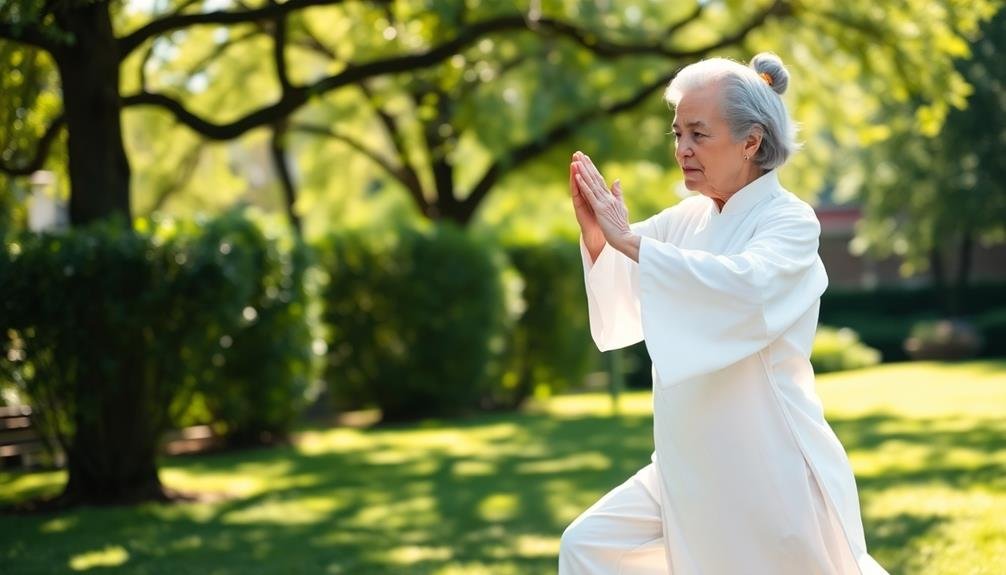
Practicing Tai Chi offers a unique pathway to cultivating mindfulness. As you engage in the slow, deliberate movements, you're encouraged to focus on the present moment, letting go of worries about the past or future. This heightened awareness of your body and breath naturally leads to a more mindful state.
During your Tai Chi practice, you'll learn to tune into subtle physical sensations, from the feel of your feet on the ground to the gentle stretch in your muscles. This bodily awareness extends to your breath, as you synchronize your movements with your inhalations and exhalations. By consistently directing your attention to these physical experiences, you're training your mind to stay present.
Over time, you'll find that this mindfulness extends beyond your Tai Chi sessions. You'll become more attuned to your thoughts and emotions in daily life, able to observe them without getting caught up in reactivity.
This increased self-awareness can help you manage anxiety more effectively, as you'll be better equipped to recognize and address stress triggers before they escalate.
Tai Chi's Impact on Nervous System
When you practice Tai Chi, you're activating your parasympathetic nervous system, which promotes a state of calm and relaxation.
This activation can help reduce your body's stress hormones, like cortisol and adrenaline.
As a result, you'll likely experience decreased anxiety and improved overall well-being through regular Tai Chi sessions.
Parasympathetic Activation Promotes Calm
As you engage in Tai Chi, your body's parasympathetic nervous system kicks into gear, promoting a state of calm and relaxation. This "rest and digest" system counteracts the effects of stress and anxiety, allowing you to find balance and tranquility.
Through slow, deliberate movements and deep breathing, Tai Chi activates your parasympathetic response, leading to numerous benefits for your mental and physical well-being.
When your parasympathetic nervous system is activated during Tai Chi, you'll experience:
- Decreased heart rate and blood pressure
- Improved digestion and metabolism
- Enhanced immune function and healing
These physiological changes contribute to an overall sense of calm and well-being.
As you practice Tai Chi regularly, you'll find that your body becomes more adept at engaging the parasympathetic nervous system, making it easier to maintain a state of relaxation even in stressful situations.
This increased resilience can help you manage anxiety more effectively in your daily life, allowing you to approach challenges with a clearer mind and a more balanced emotional state.
Stress Hormone Reduction Effects
Tai Chi's gentle movements and mindful practices trigger a cascade of hormonal changes in your body, greatly reducing stress hormone levels. As you practice, your cortisol levels drop considerably, easing feelings of anxiety and tension. This reduction in stress hormones helps you feel more relaxed and centered, both during and after your Tai Chi session.
The slow, flowing movements of Tai Chi also stimulate the production of endorphins, your body's natural feel-good chemicals. These endorphins not only boost your mood but also help reduce pain and promote a sense of well-being. Additionally, Tai Chi practice increases the release of serotonin, a neurotransmitter that plays a vital role in regulating mood and anxiety levels.
| Hormone | Effect | Tai Chi's Impact |
|---|---|---|
| Cortisol | Stress and anxiety | Decreases levels |
| Endorphins | Pain relief, mood boost | Increases production |
| Serotonin | Mood regulation | Enhances release |
| Adrenaline | Fight-or-flight response | Reduces secretion |
Building Physical and Mental Balance
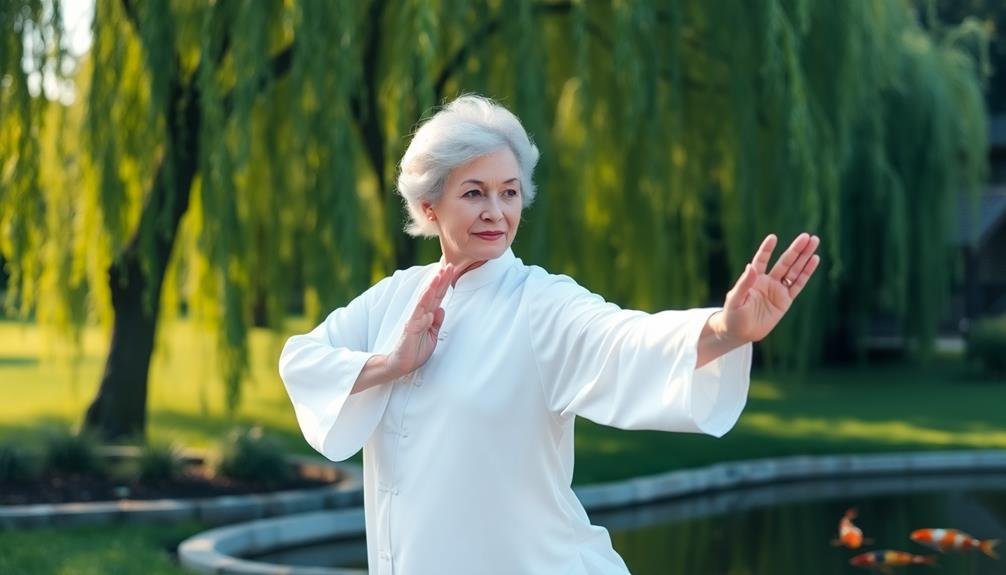
Many practitioners find that Tai Chi's gentle, flowing movements foster both physical and mental equilibrium. As you practice, you'll notice improvements in your balance, posture, and body awareness. These physical benefits naturally extend to your mental state, creating a sense of calm and centeredness.
Tai Chi's focus on slow, deliberate movements and deep breathing helps you:
- Develop mindfulness and present-moment awareness
- Improve concentration and mental clarity
- Enhance mind-body connection
You'll learn to sync your breath with your movements, which can help reduce anxiety and promote relaxation. This synchronization also trains your mind to stay focused on the present, rather than dwelling on worries about the future or past regrets.
As you progress in your practice, you'll find that the balance you cultivate on the mat extends to other areas of your life. You'll become more adept at maintaining emotional equilibrium in stressful situations and may even notice improved decision-making skills.
The physical and mental balance fostered by Tai Chi can lead to a greater sense of overall well-being and resilience in the face of life's challenges.
Social Benefits of Group Classes
Why practice Tai Chi alone when you can reap the social benefits of group classes? Joining a Tai Chi group offers you the chance to connect with like-minded individuals who share your interest in mindfulness and physical well-being.
You'll find a supportive community that encourages your progress and helps you stay motivated. Group classes provide a structured environment where you can learn from both the instructor and your peers.
You'll pick up tips and techniques by observing others, and you might even find yourself inspired by their dedication. The gentle, non-competitive nature of Tai Chi fosters a welcoming atmosphere where you can feel comfortable regardless of your skill level.
Regular attendance at group classes can help combat feelings of isolation and loneliness, which are often associated with anxiety. You'll have the opportunity to form new friendships and expand your social network.
The shared experience of learning and practicing Tai Chi together can create a sense of camaraderie and belonging. Plus, the simple act of engaging in social interaction during class can boost your mood and reduce stress levels, complementing the anxiety-reducing effects of Tai Chi itself.
Adapting Tai Chi for Beginners
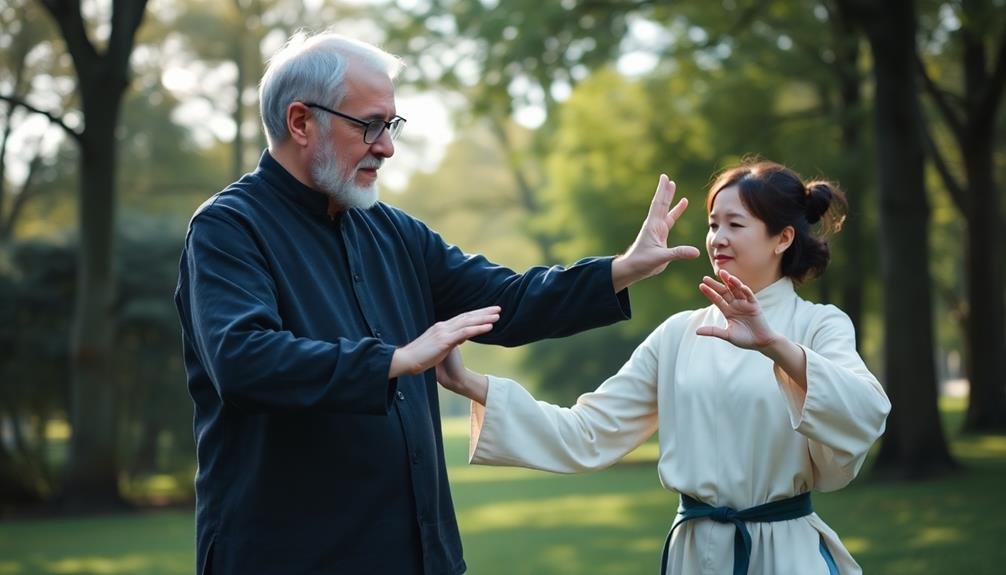
For those new to the practice, adapting Tai Chi doesn't have to be intimidating. You can start by focusing on the basic principles and movements, gradually building your skills over time. Begin with shorter sessions, perhaps 10-15 minutes, and slowly increase the duration as you become more comfortable.
When adapting Tai Chi for beginners, consider these key points:
- Simplify the movements: Start with basic stances and gestures, mastering them before moving on to more complex forms.
- Focus on breathing: Concentrate on deep, slow breaths synchronized with your movements to enhance relaxation and mindfulness.
- Use visual aids: Watch instructional videos or mirror your instructor's movements to improve your form and technique.
Don't worry about perfecting every move right away. Instead, pay attention to how your body feels and maintain a relaxed posture.
If you have physical limitations, modify the movements to suit your needs. Remember, Tai Chi is adaptable and can be practiced by people of all ages and fitness levels.
As you progress, you'll naturally become more fluid and confident in your practice.
Incorporating Qigong With Tai Chi
Incorporating Qigong with Tai Chi can enhance your overall practice and deepen its benefits for anxiety reduction. Qigong, which focuses on breath work and energy cultivation, complements Tai Chi's flowing movements. By combining these practices, you'll create a more holistic approach to managing anxiety.
Start by learning basic Qigong exercises, such as "Lifting the Sky" or "Standing Like a Tree." These exercises help you cultivate qi (energy) and improve your focus. As you progress, integrate Qigong principles into your Tai Chi routine. Pay attention to your breath, visualize energy flowing through your body, and maintain a meditative state throughout your practice.
Here's a table comparing Qigong and Tai Chi elements you can incorporate:
| Qigong Element | Tai Chi Application |
|---|---|
| Deep breathing | Coordinate with movements |
| Energy cultivation | Focus on dantian |
| Visualization | Imagine energy flow |
| Stillness | Pause between forms |
| Intention setting | Direct qi with mind |
Daily Practice for Anxiety Management
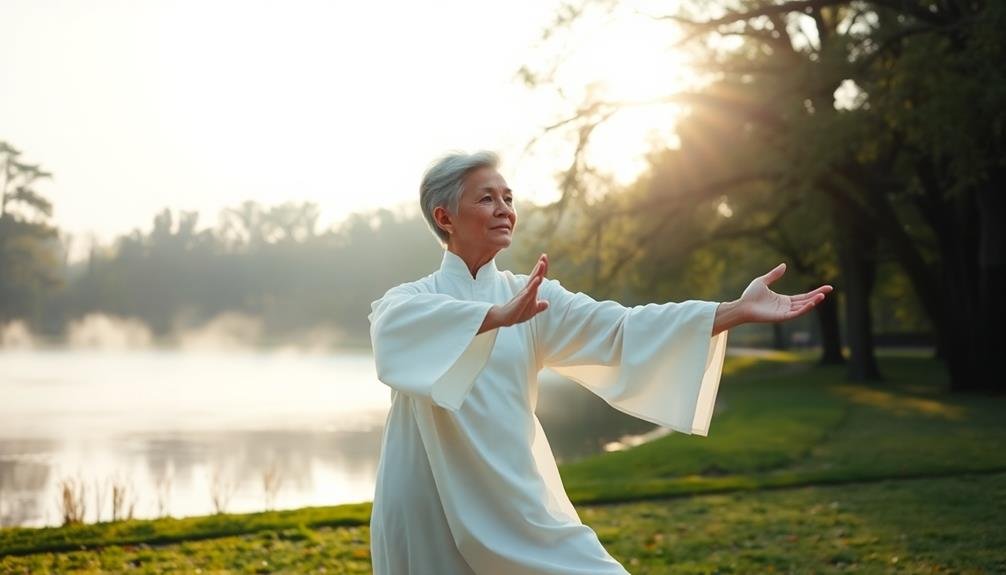
To manage anxiety through Tai Chi, you'll need to establish a daily routine.
By setting aside time each day for your practice, you're creating a consistent habit that can greatly impact your mental well-being.
As you maintain this routine, you'll likely find your confidence growing, both in your Tai Chi skills and in your ability to handle anxiety-inducing situations.
Establishing a Routine
Developing a consistent Tai Chi practice is essential for managing anxiety effectively. To establish a routine, start by setting aside a specific time each day for your practice. Choose a time when you're least likely to be interrupted, such as early morning or just before bed. Aim for at least 15-20 minutes daily, gradually increasing the duration as you become more comfortable with the movements.
Create a dedicated space for your Tai Chi practice, free from distractions. This can be a quiet corner in your home or a peaceful outdoor area. Make certain you have enough room to move freely and comfortably.
To maintain motivation and track your progress, consider:
- Using a habit-tracking app or calendar to mark your daily practice
- Joining a Tai Chi class or online community for support and accountability
- Setting achievable goals and rewarding yourself for consistency
Remember that consistency is key. Even on days when you're feeling anxious or unmotivated, try to stick to your routine.
Over time, you'll likely find that your Tai Chi practice becomes a grounding and calming ritual that you look forward to each day.
Consistency Builds Confidence
With consistent daily practice, Tai Chi becomes a powerful tool for managing anxiety and building self-confidence. As you commit to a regular routine, you'll notice gradual improvements in your physical balance, mental clarity, and emotional stability. This consistent progress reinforces your ability to manage anxiety, creating a positive feedback loop that boosts your self-assurance.
Daily practice helps you internalize Tai Chi's calming principles, making them more accessible during stressful situations. You'll find yourself naturally applying deep breathing techniques and mindful movements when faced with anxiety triggers. This automatic response cultivates a sense of control over your emotional state.
Moreover, the discipline required for daily practice strengthens your overall willpower and resilience. As you overcome the initial challenges of establishing a routine, you'll develop a greater sense of accomplishment and self-efficacy.
This newfound confidence extends beyond your Tai Chi practice, positively impacting other areas of your life.
Choosing the Right Tai Chi Style
Selecting the appropriate Tai Chi style is essential for managing anxiety effectively. With numerous styles available, you'll want to choose one that aligns with your goals and physical capabilities. Consider starting with Yang style, the most popular and widely practiced form. It's known for its gentle, flowing movements and is often recommended for beginners and those seeking stress relief.
When choosing a Tai Chi style for anxiety management, keep these factors in mind:
- Pace: Some styles, like Chen, are more vigorous and may not be suitable if you're looking for a calming practice.
- Complexity: Styles like Wu and Sun are more compact and may be easier to learn in smaller spaces.
- Focus: Different styles emphasize various aspects, such as breathing, meditation, or self-defense applications.
You might also explore Qigong, a related practice that focuses more on breathing and meditation. It's often incorporated into Tai Chi classes and can be particularly beneficial for anxiety relief.
Don't hesitate to try different styles or instructors until you find the right fit. Remember, the best Tai Chi style for anxiety is the one you'll practice consistently.
Frequently Asked Questions
Can Tai Chi Help With Specific Anxiety Disorders Like PTSD or OCD?
Yes, Tai Chi can help with specific anxiety disorders like PTSD and OCD. You'll find its mindful movements and deep breathing techniques can reduce symptoms, improve focus, and promote relaxation. It's a gentle, effective practice for managing these conditions.
How Long Does It Take to See Anxiety-Reducing Benefits From Tai Chi?
You'll likely notice anxiety-reducing effects within a few weeks of regular practice. However, it's different for everyone. Stick with it for 2-3 months, and you'll experience more significant benefits. Consistency is key to seeing results.
Are There Any Potential Risks or Side Effects of Practicing Tai Chi?
You'll find Tai Chi is generally safe, but there are a few risks to contemplate. You might experience muscle soreness, fatigue, or minor aches initially. If you've got existing health issues, it's best to consult your doctor first.
Can Children or Elderly Individuals Practice Tai Chi for Anxiety Relief?
Yes, you'll find that tai chi is suitable for both children and the elderly. It's a gentle, low-impact exercise that can help reduce anxiety at any age. You'll want to guarantee proper instruction and adapt movements as needed.
How Does Tai Chi Compare to Other Anxiety Management Techniques Like Meditation?
You'll find Tai Chi and meditation both reduce anxiety effectively. While meditation focuses on stillness, Tai Chi combines gentle movement with mindfulness. It's often easier for beginners and provides physical benefits alongside mental calmness.
In Summary
You've now discovered why Tai Chi can be a powerful tool for easing anxiety. By embracing its ancient wisdom, connecting your mind and body, and practicing mindful movements, you're equipping yourself with valuable stress-reduction techniques. Remember, it's not about perfection but consistency. Start small, be patient with yourself, and gradually incorporate Tai Chi into your daily routine. You'll likely find that as your practice grows, your anxiety diminishes, leading to a calmer, more balanced life.

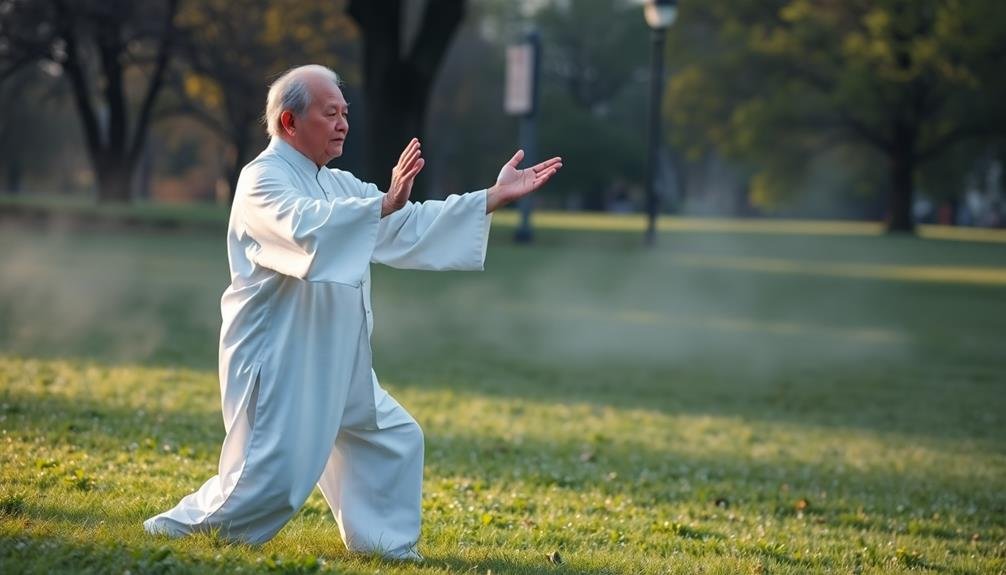



Leave a Reply